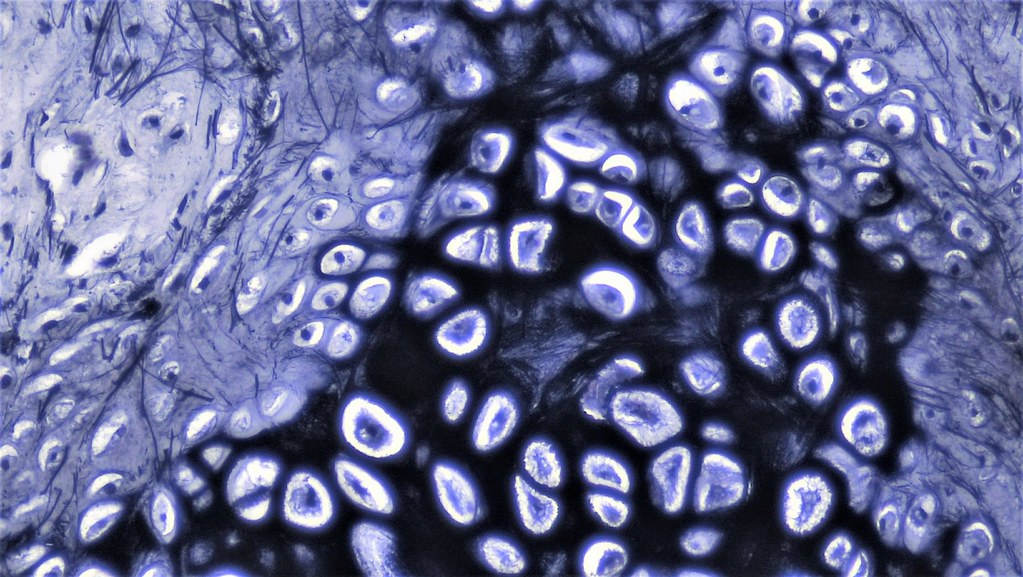Playlist
Show Playlist
Hide Playlist
Does Cartilage Grow and can it be Repaired?
-
Slides 07 Types of Tissues Meyer.pdf
-
Download Lecture Overview
00:02 Let us look and see how cartilage grows. When we look at the outside of cartilage, both hyaline cartilage and elastic cartilage are surrounded by a capsule. I've mentioned the term capsule before in my general lecture on connective tissues. Well, in the case of cartilage, both hyaline, and both elastic cartilage, the capsule is really called the perichondrium. Peri meaning around, chondrium cartilage. We will see that bone has a similar capsule called the periosteum, around bone. Well, if you look very carefully at this image, again try and point out to yourself, a chondrocyte. Remember what I said about the lacunar space, try and identify a lacunar space in this image. Well look on the outside of the cartilage. It is very fibrous. 01:08 On the very very edge, you can see two tiny little round circles. They represent little blood vessels coming into the capture of the cartilage. That is how the cartilage gets its nutrition from those blood vessels on the outside and the nutrients, the oxygen diffusing through the aqueous component of the cartilage that I mentioned earlier when I described nutrition to articular cartilage via the synovial fluid. But that capsule has two layers, an outer fibrous layer and an inner chondrogenic layer. And that inner chondrogenic layer, if you look very carefully this image, you can just see a region where there are some cells with elongated nuclei. Or on the very edge of the cartilage, you see thinner, smaller chondrocytes and they are packed a little bit closer together. Well that is the chondrogenic layer. 02:09 And during development, those cells can continually divide and form cartilage cells and deposit matrix. 02:18 And therefore the cartilage can grow in thickness. We call that appositional growth, growth on the outside to increase the thickness of the cartilage. Whereas interstitial growth is growth within the cartilage. I've mentioned earlier isogenous groups. These represent where cartilage cells are dividing and when they divide, they are very close together, but then they start to secrete matrix and they move further and further apart, which is why you see in sections of cartilage, some chondrocytes isolate on their own, whereas others are lying very close together representing the stages of appositional growth. And once the cartilage matures, then the chondrogenic layer on the perichondrium disappears or at least is very minimum and also the cartilage cells within the matrix lose the ability to divide. So the question is, can damaged cartilage be repaired? And really the simple answer is no. 03:37 Why? Because of the fact that that perichondrium, particularly the chondrogenic layer dwindles as the cartilage matures and therefore there are very very few cells or stem cells there that can divide and bud off and therefore allow the cartilage to repair itself if it is damaged. 04:00 The cells within the cartilage, the chondrocytes, lose their ability to divide as well. And also as I mentioned earlier, cartilage is avascular. It does not have a direct blood supply and therefore that impairs any ability for a tissue to be able to repair itself. Often if cartilage becomes vascularized through injury, it turns into bone. So normally cartilage has very very limited abilities to be able to repair itself when damaged. 04:36 So, in final summary, make sure you are aware of the structural and the functional differences between the three types of cartilage. Hyaline, elastic and fibrocartilage have really three different sorts of fibre types. Make sure you understand a little bit about the matrix components, particularly the glycoaminoglycans that bind the water into the cartilage and resist compressive forces. Make sure you are aware of the importance of the perichondrium during growth of cartilage, during development, the chondrogenic layer on the inside and the more fibrous layer on the outside. This gives rise to appositional growth of cartilage, whereas cartilage can grow within as well because of the ability for the cartilage cells within the matrix components to divide. And just refresh your memory again on what I said just a few moments ago as to why cartilage cannot repair itself. 05:52 So I hope you enjoy this little story about cartilage. And in my next lecture, I am going to again talk about another form of specialized connective tissue and that is bone.
About the Lecture
The lecture Does Cartilage Grow and can it be Repaired? by Geoffrey Meyer, PhD is from the course Connective Tissue.
Included Quiz Questions
What is the layer of connective tissue that surrounds the cartilage?
- Perichondrium
- Periosteum
- Endosteum
- Matrix
- Lamina propria
During development, the cells in the chondrogenic layer continually divide and form cartilage cells and deposit matrix. What is the name for this type of growth?
- Appositional growth
- Interstitial growth
- Chondrogenesis
- Exterior growth
- Interior growth
What is the name of the inner layer of perichondrium that is most evident during development?
- Chondrogenic layer
- Fibrous layer
- Interstitial layer
- Elastic layer
- Perichondrium
What is the name for the clusters of closely spaced dividing cartilage cells that are within the chondrogenic layer?
- Isogenous groups
- Exogenous groups
- Osteocytes
- Chondroblasts
- Fibrochondroblasts
Customer reviews
5,0 of 5 stars
| 5 Stars |
|
5 |
| 4 Stars |
|
0 |
| 3 Stars |
|
0 |
| 2 Stars |
|
0 |
| 1 Star |
|
0 |




